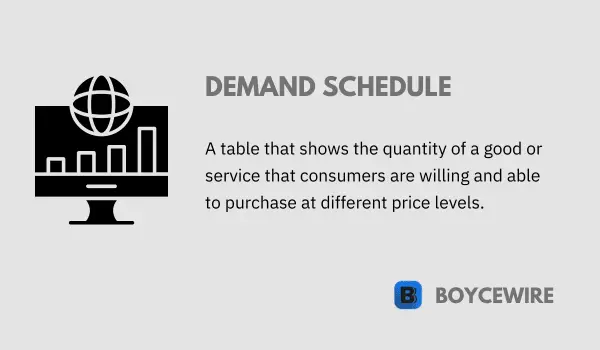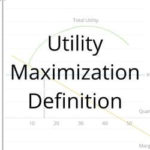Demand Schedule: Definition, Components & Examples

What is a Demand Schedule?
In the realm of economics, understanding the concept of demand is crucial for businesses, economists, and policy makers alike. One key tool used in the analysis of demand is the “Demand Schedule”. This fundamental instrument provides a tabular representation of the relationship between the price of a good or service and the quantity of that good or service that consumers are willing and able to purchase, ceteris paribus (all other things being equal).
It plays a vital role in helping businesses price their products, manage inventory, and strategize for market trends, among other things. In this article, we will delve into the intricacies of the demand schedule, exploring its components, how it is created, its applications and limitations, and providing real-world examples of its use.
Key Points
- A demand schedule presents the relationship between the price of a product and the quantity demanded by consumers.
- It helps illustrate the law of demand, which states that as the price of a product increases, the quantity demanded decreases, and vice versa.
- A demand schedule typically lists different price levels in one column and the corresponding quantity demanded in another column.
Understanding Demand Schedule
A demand schedule is a tool in economics that graphically illustrates the quantity of a good or service that consumers are willing to purchase at various price points. This schedule is essential for understanding the law of demand, which states that as the price of a good or service increases, consumer demand for it decreases, and vice versa, all other things being equal.
It can be presented in two formats: individual demand schedule and market schedule. An individual demand schedule represents the quantity demanded by an individual consumer at different price levels. On the other hand, a market schedule aggregates the individual demand schedules of all consumers in a market to show the total quantity demanded at different price levels.
Each row represents a different price for the good or service in question. Each column shows the quantity demanded at that price. The schedule allows for easy comparison of demand quantities at different prices and enables a quick visualization of how changes in price can affect consumer demand. This understanding is crucial for suppliers when deciding on pricing strategies, sales forecasts, and inventory management.
Components of a Demand Schedule
- Price of the Good or Service The different price levels at which the good or service is available for purchase are represented in the demand schedule. It is typically listed in descending order, starting with the highest price.
- Quantity Demanded This is the amount of the good or service that consumers are willing to purchase at each specific price point. This quantity can vary greatly based on the price and is generally inversely proportional to it.
- Individual and Market Demand The demand schedule can represent the buying patterns of an individual consumer (individual schedule) or aggregate demand from all consumers in a given market (market schedule). The market demand schedule is often of greater interest to economists and businesses as it provides a more comprehensive view of market dynamics.
- Time Period It is typically related to a specific time period, which can range from one day to one year or more. This time period is important, as consumer demand can change over time due to various factors such as seasonal trends, changes in income, or changes in consumer preferences.
Creation of a Demand Schedule
- Identify the Good or Service Clearly define the product or service for which you are creating the demand schedule.
- Determine Price Points Decide on a range of different price points for the good or service. These prices should cover a range that is realistic for the product and the market.
- Estimate Quantity Demanded at Each Price For each of the price points identified, estimate the number of units that consumers would be willing to purchase at that price. This estimation can be derived from past sales data, market research, surveys, or demand forecasting techniques.
- Create a Table Construct a table with two columns. The first column should list the different price points, and the second column should list the corresponding quantity demanded. It’s common to list the price points in descending order, starting with the highest price.
- Plot the Demand Curve Once you have your demand schedule laid out in tabular form, you can then plot it on a graph, creating a demand curve. Price goes on the vertical axis (y-axis), and quantity demanded goes on the horizontal axis (x-axis).
- Consider the Time Frame Demand can change over time due to a variety of factors. Thus, it’s important to indicate the relevant time period your demand schedule covers.
Demand Curve
A demand curve is a graphical representation of a demand schedule. It shows the relationship between the price of a good or service and the quantity of that good or service that consumers are willing and able to purchase at various prices.
The demand curve is typically downward sloping, indicating an inverse relationship between price and quantity demanded. As the price of a good or service decreases, the quantity demanded usually increases, and vice versa. This inverse relationship is known as the “law of demand.”
The demand curve can shift to the left or the right in response to changes in factors other than price, such as consumers’ income, preferences, expectations about future prices, or changes in the price of related goods.
A shift to the right represents an increase in demand, meaning consumers are willing to purchase more of the good or service at each price point. A shift to the left represents a decrease in demand, meaning consumers are willing to purchase less of the good or service at each price point.
In some cases, demand curves can have a different shape. For instance, a perfectly inelastic demand curve is vertical, indicating that quantity demanded does not change with price. Conversely, a perfectly elastic demand curve is horizontal, indicating that consumers are willing to buy any quantity of the product at a certain price, but nothing at all above that price.
The demand curve, together with the supply curve, forms the core of market economics, and it serves as a fundamental tool of economic analysis.
Applications of the Demand Schedule
The demand schedule and its graphical representation, the demand curve, are fundamental tools in economic analysis. Here are some of their practical applications:
- Price Determination Together with the supply schedule, the demand schedule helps to determine the equilibrium price in a market. The equilibrium price is the price at which the quantity demanded by consumers equals the quantity supplied by producers.
- Demand Forecasting Businesses can use demand schedules to predict how changes in price will affect the demand for their products. This can help them in planning production, setting prices, and developing marketing strategies.
- Policy Making Governments can use demand schedules to understand how changes in policy might affect demand for certain goods or services. For example, a it could help to predict the effects of a proposed tax on tobacco products on the consumption of cigarettes.
- Consumer Surplus Demand schedules can be used to calculate consumer surplus, which is a measure of the economic benefit that consumers receive when they are able to purchase a product for a price that is less than the maximum they are willing to pay.
- Elasticity Analysis The shape and slope of the demand curve can provide insights into the price elasticity of demand for a product, which is a measure of the responsiveness of quantity demanded to changes in price. This information can be very useful to businesses in making pricing decisions.
In all these ways, the demand schedule plays a crucial role in understanding market dynamics and guiding economic decision-making.
Examples of Demand Schedule
A demand schedule is a tabular representation of the quantities of a good or service that consumers are willing and able to purchase at various prices, assuming all other non-price factors remain the same.
Here are a couple of examples to illustrate:
Example 1 – Demand for Apples
Let’s consider a simplified example where we are looking at the demand for apples in a local market. The price per apple (in USD) and the quantity demanded per day are as follows:
| Price per Apple (USD) | Quantity Demanded (Apples per day) |
|---|---|
| 0.5 | 200 |
| 1 | 180 |
| 1.5 | 150 |
| 2 | 120 |
| 2.5 | 90 |
This table indicates that as the price of an apple increases, the quantity of apples that consumers are willing and able to purchase decreases, illustrating the law of demand.
Example 2 – Demand for Movie Tickets
Now let’s look at another example, considering the demand for movie tickets. The price per ticket (in USD) and the quantity demanded per week are as follows:
| Price per Ticket (USD) | Quantity Demanded (Tickets per week) |
|---|---|
| 5 | 400 |
| 10 | 350 |
| 15 | 300 |
| 20 | 240 |
| 25 | 180 |
Again, we see that as the price of movie tickets increases, the quantity of tickets that consumers are willing and able to purchase decreases.
These are just simple examples, and actual demand schedules in real-life scenarios could be influenced by a wide variety of factors and could be much more complex. However, these examples serve to illustrate the basic principle.
FAQs
A demand schedule is a tabular representation of the relationship between the price of a product and the corresponding quantity demanded by consumers.
A demand schedule is created by observing and recording the quantity demanded at various price levels, holding other factors constant.
A demand schedule shows the quantity demanded at different price points, helping to illustrate the inverse relationship between price and quantity demanded.
A demand schedule presents data in tabular form, while a demand curve represents the same information graphically.
About Paul
Paul Boyce is an economics editor with over 10 years experience in the industry. Currently working as a consultant within the financial services sector, Paul is the CEO and chief editor of BoyceWire. He has written publications for FEE, the Mises Institute, and many others.

Further Reading
 Bait and Switch - Bait and switch is a deceptive sales tactic that involves advertising a desirable product or offer to attract customers, only…
Bait and Switch - Bait and switch is a deceptive sales tactic that involves advertising a desirable product or offer to attract customers, only…  Money Laundering - Money laundering is the process of disguising the origins of illegally obtained money to make it appear legitimate.
Money Laundering - Money laundering is the process of disguising the origins of illegally obtained money to make it appear legitimate.  Utility Maximization: Definition, Example & Limitations - Table of Contents What is Utility Maximization Utility Maximization Rule Utility Maximization Example Limitations of Utility Maximisation Utility Maximization FAQs…
Utility Maximization: Definition, Example & Limitations - Table of Contents What is Utility Maximization Utility Maximization Rule Utility Maximization Example Limitations of Utility Maximisation Utility Maximization FAQs… 